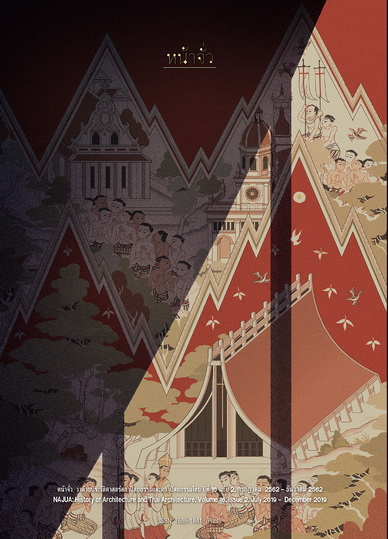The Characteristics of Vernacular House Plans in Northeast Thailand along Chi River Basin
Main Article Content
Abstract
In Northeast Thailand, vernacular houses can be divided into three groups: Koey house, Khong house and Faed house. All share the common characteristic of orientation called “following the sun”, by which it means, the narrow sides of the biggest room in the house, usually a bedroom, are facing East-West directions, while its longer sides are towards North-South directions. This paper studies the orientation of the Northeast vernacular dwellings, focusing on ways in which their main rooms such as bedroom, kitchen, terraces, and stair are located and organised. From the case studies of 22 houses in total, 19 of which are planned as “following the sun”, which can further be categories into 2 sub-groups: the first group, consisting of 9 houses, has bedroom in the North; the second group, composed of 5 houses, has bedroom in the South. In both cases, however, the kitchen is always located in the West, and whichever side the stair is situated, the bedroom is on the opposite side; for example, if the stair is located in the North, the bedroom is towards the South. This house orientation shows local wisdom in designing with the local climatic conditions and the use of domestic spaces at different times of the day in mind.
Downloads
Article Details
References
Commissioner of Architects northeastern, ed. sathāpattayakam ʻĪsān [Architecture of Northeastern region (Isan) of Thailand]. Bangkok: The Association of Siamese Architects under Royal Patronage, 1987.
kha lam khalam: čhārītpraphēnī chāo ʻĪsān [Khalam Customary northeast]. Accessed December 1, 2019. Available from https://www.isangate.com/new/ka-lam-isan.html
Meteorological Department, khwāmrū ʻutuniyomwitthayā [Climate of Thailand]. Accessed December 1, 2019. Available from https://www.tmd.go.th/info/info.php?FileID=22
Montri Khotkhantha. hư̄an ʻĪsān (bān khon ʻĪsān) [Isan house]. Accessed December 1, 2019. Available from https://www. isangate.com/new/isanland/31-art-culture/ tradition/ 653-huen-isan.html
Songyot Wirathawimat, and others. sathāpat tayakam singwǣtlō̜m nai rư̄an phư̄n thin thai Lāo nai phāk ʻĪsān khō̜ng prathēt Thai læ nai Sō̜Pō̜Pō̜. Lāo [Sustainable qualities in Thai-Lao Vernacular Houses of the Northeast Thailand and Lao PDR]. Khon Kaen: Faculty of Architecture, Khon Kaen University, 2005.
Suwit Chiramani. “sathāpattayakam phư̄n thin ʻĪsān (sāi watthanatham Thai-Lāo) [Vernacular architecture Isan (culture Thailand – Laos)].” In khwāmlāklāi khō̜ng rư̄an phư̄n thin Thai [The Diversity of Vernacular House in Thailand]. 2nd ed. 216-223. Edited by Chinnasak Tantikul. Bangkok: Faculty of Architecture Silpakorn University, 2001.
Thanit Sathiannam and Noppadon Tangsakul. “sathānaphāp phonngā nawi chā kānkān sưksā rư̄an phư̄n thin nai phāk tawanʻō̜k chīang nư̄a khō̜ng prathēt Thai [The status of academic outputs in Vernacular house study in the Northeast of Thailand].” Academic Journal of Faculty of Architecture, Khon Kaen University 15, 1 (2559): 59-75.
Thiti Hengratsami, and others. kānsưksā rūaprūam rūpbǣp bānphak ʻāsai nai chonnabot ʻĪsān thǣp lumnam chī čhangwat Khō̜n Kǣn Maha Sarakham Kān Sin Rō̜i ʻet læ Yasō Thō̜n [Architectural development for housing in rural Isan (Chi River Basin)]. Khon Kaen: Faculty of Architecture, Khon Kaen University, 1993.
Thitiya Phakdisuwan. “ʻattalak hǣng rư̄an phư̄n thin ʻĪsān sū nǣothāngkān ʻō̜k bǣp sathāpattayakam rūamsamai [The identity of Esan vernacular house approach to contemporary architecture].” Master thesis, Faculty of Architecture Silpakorn University, 2007.


